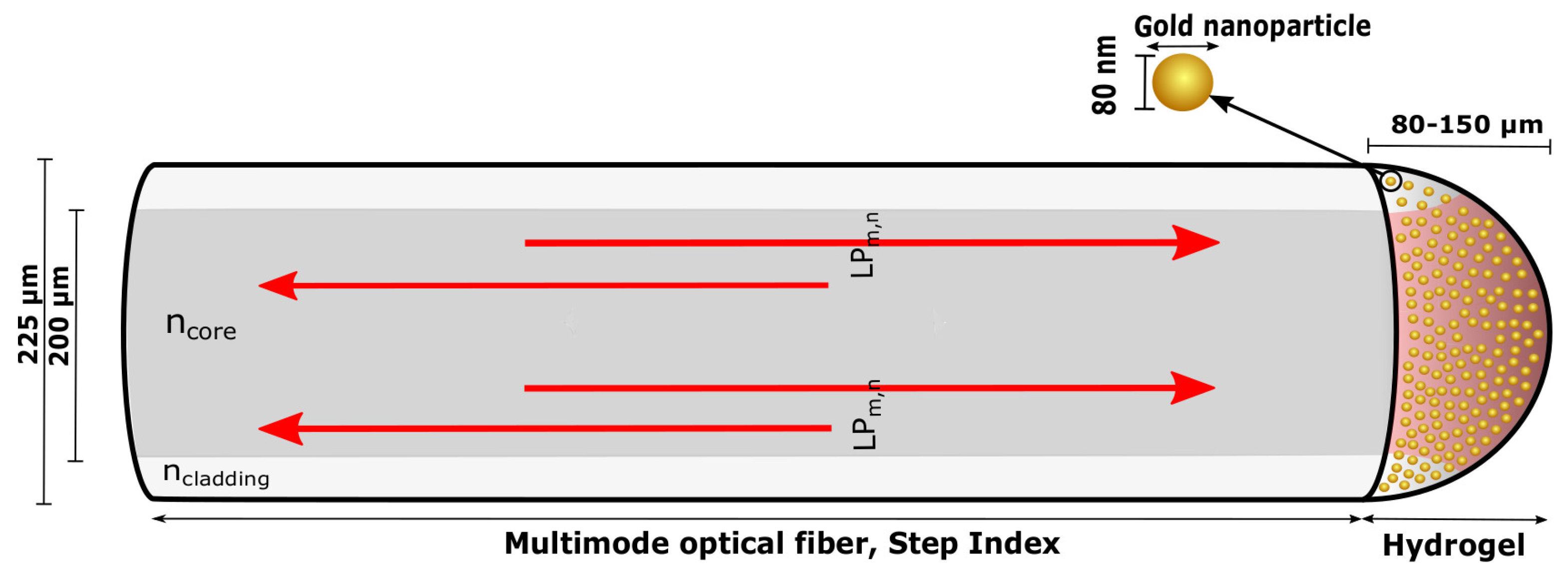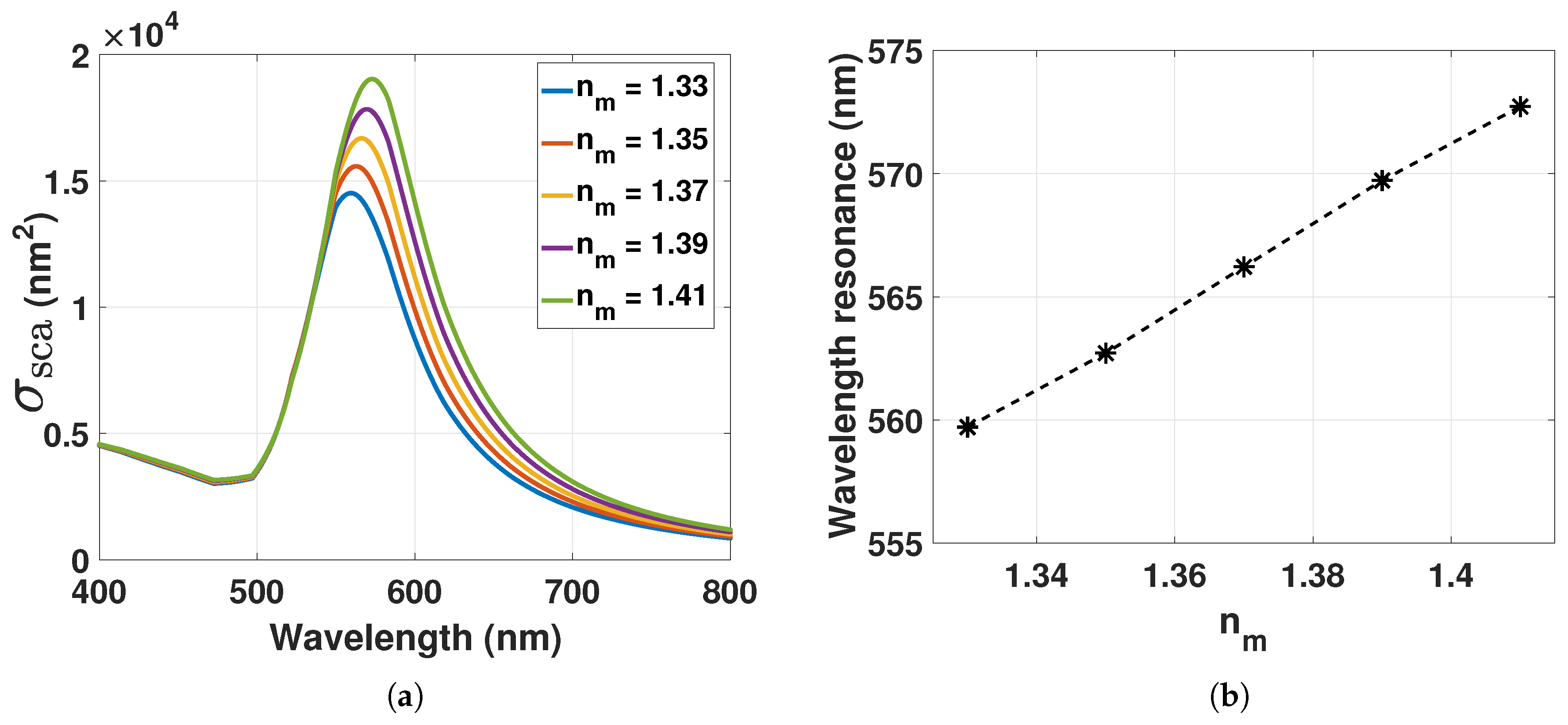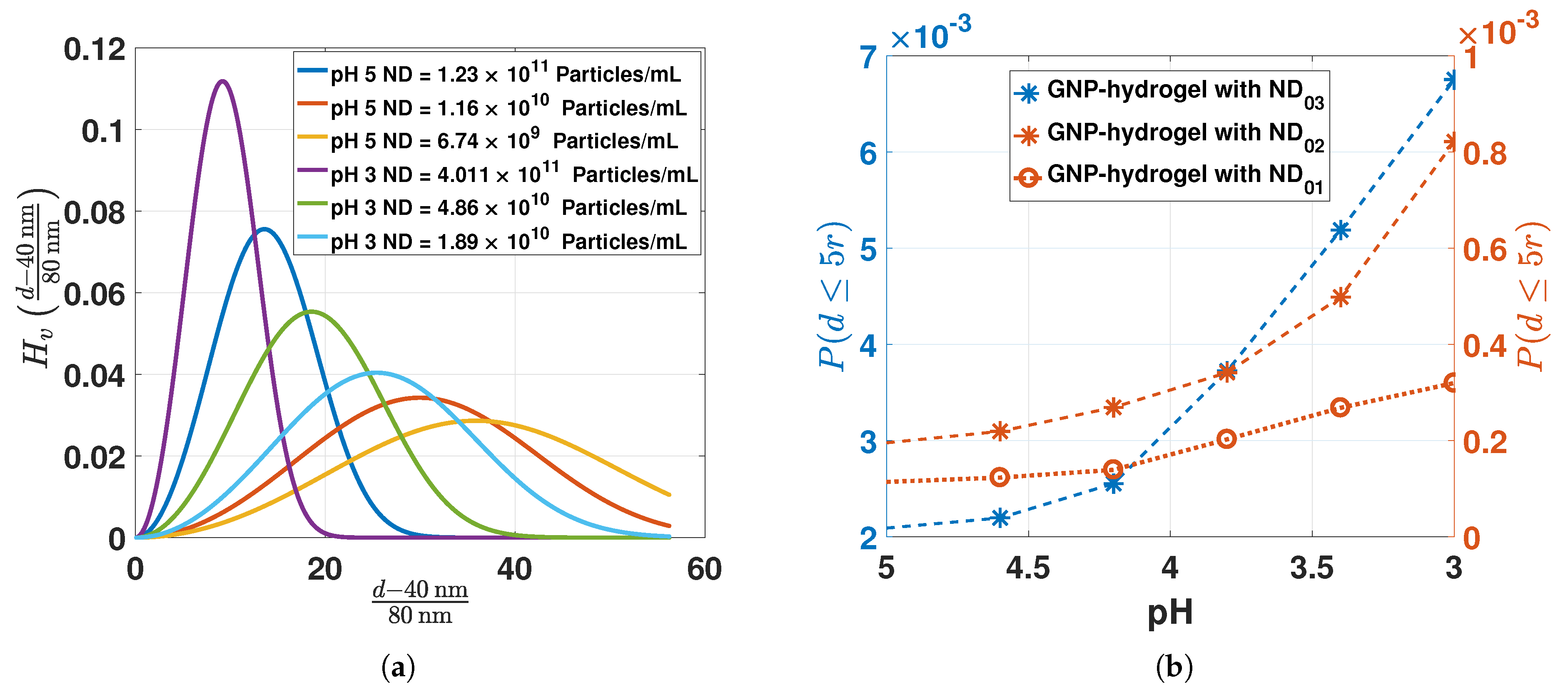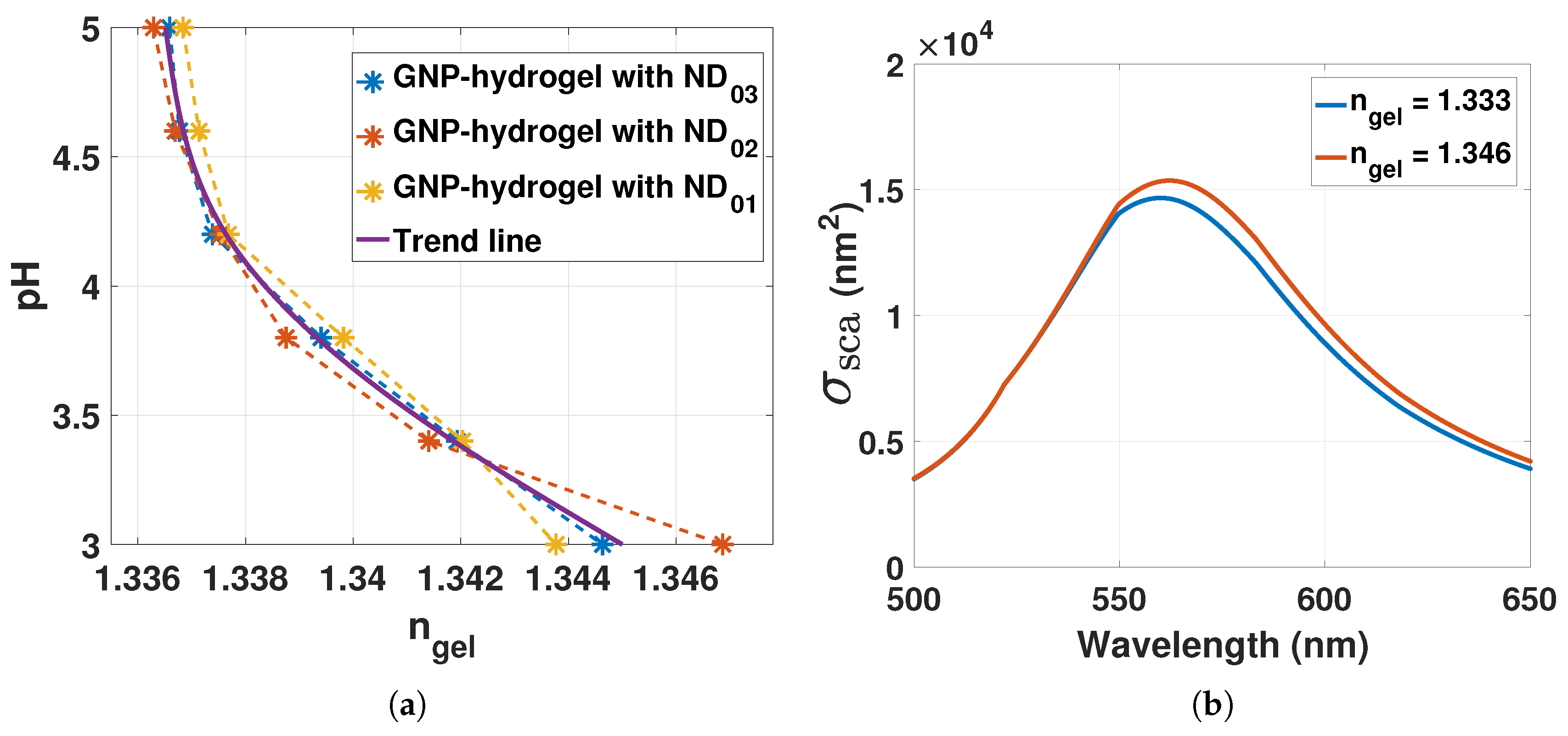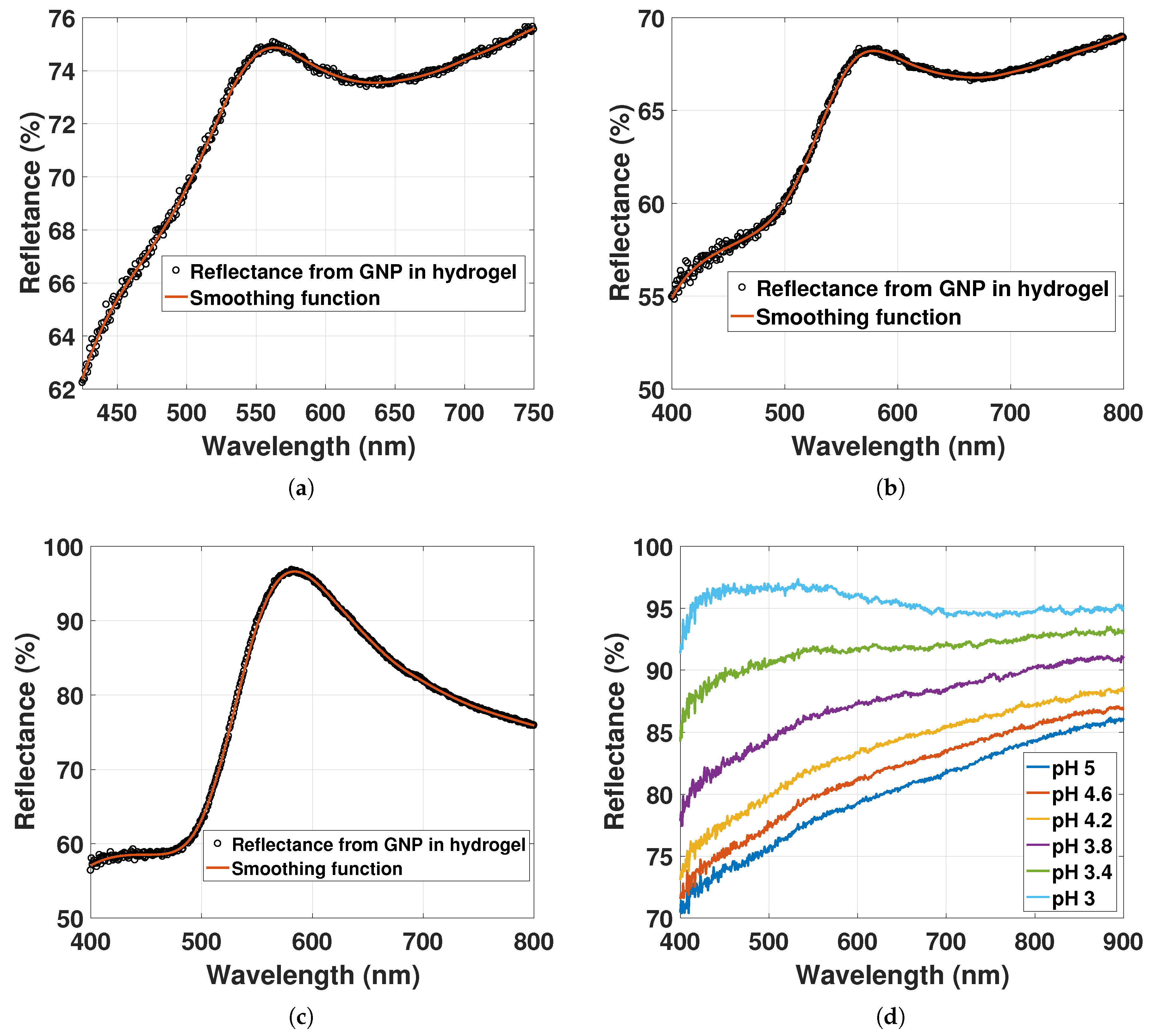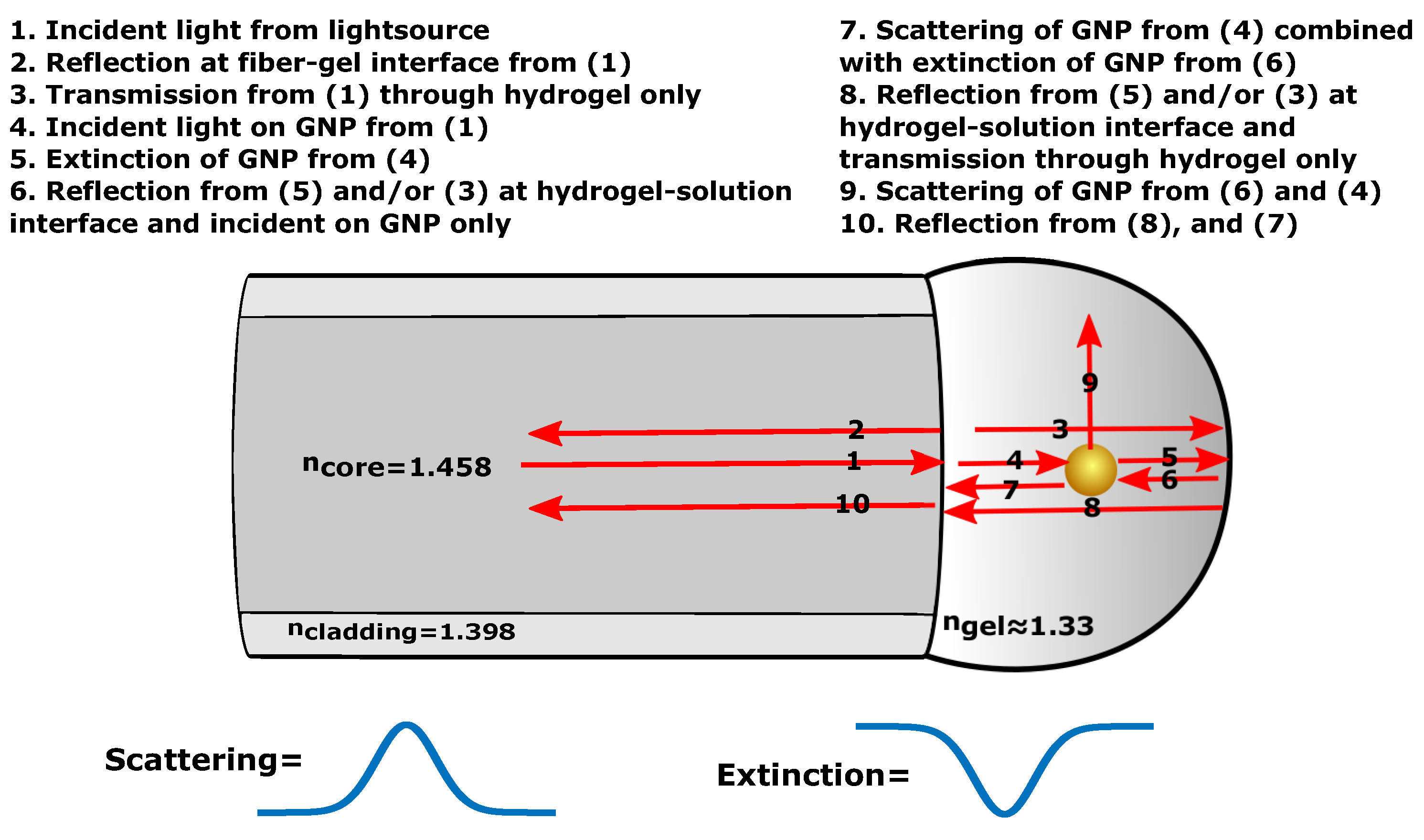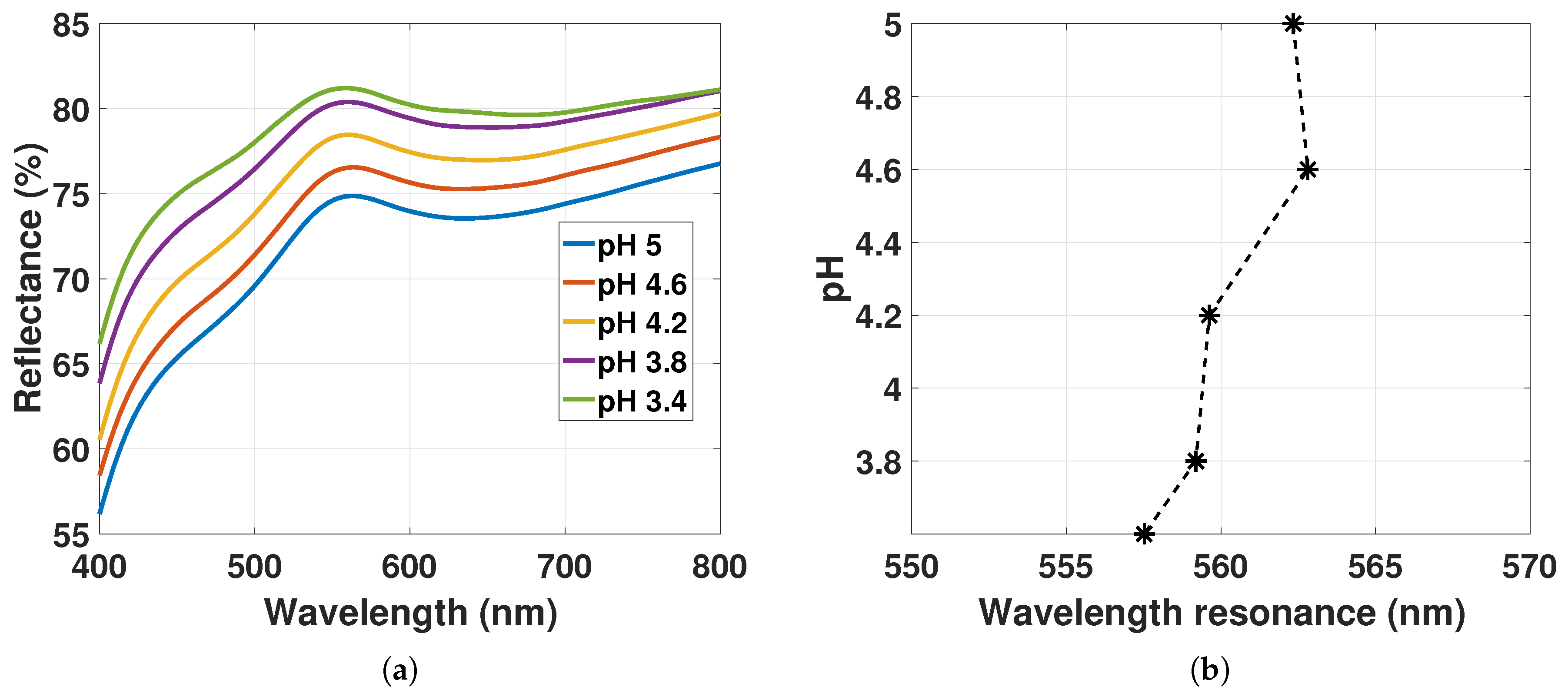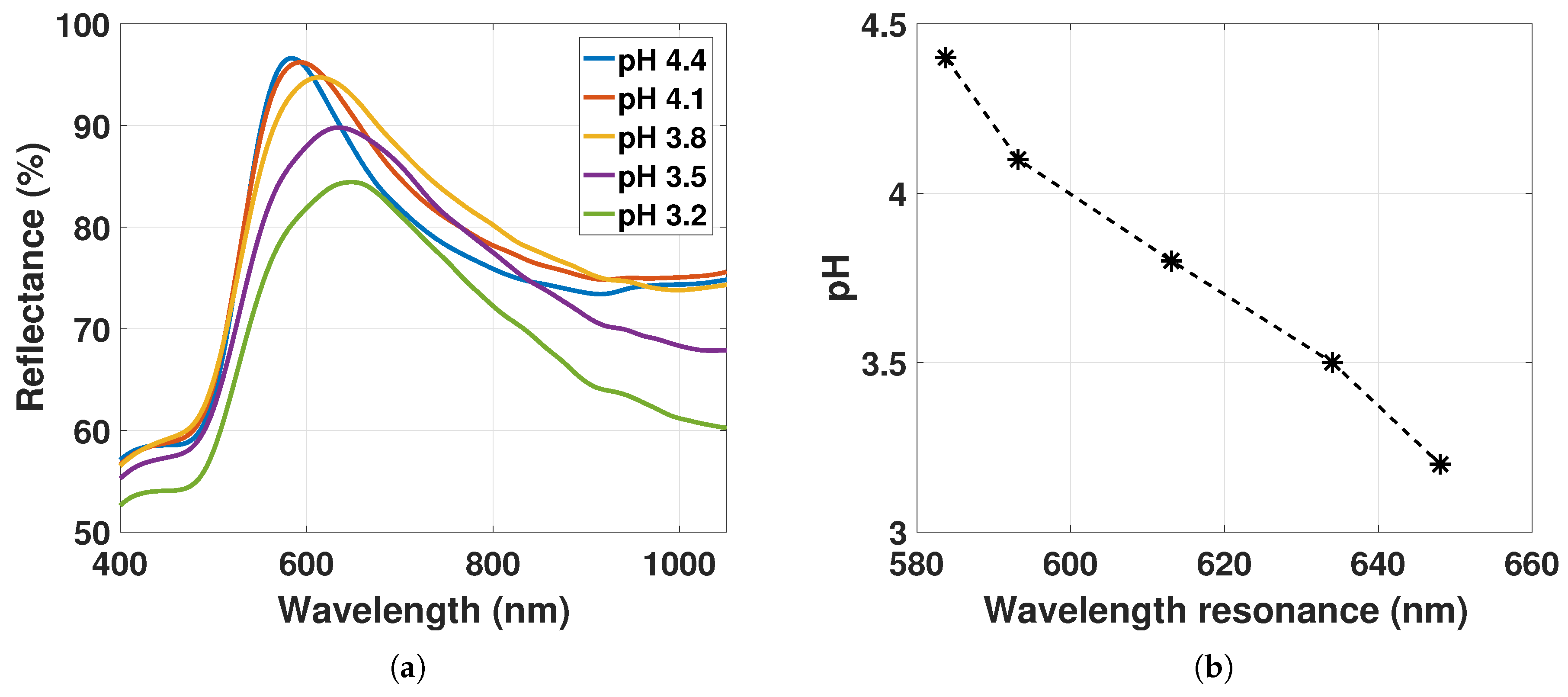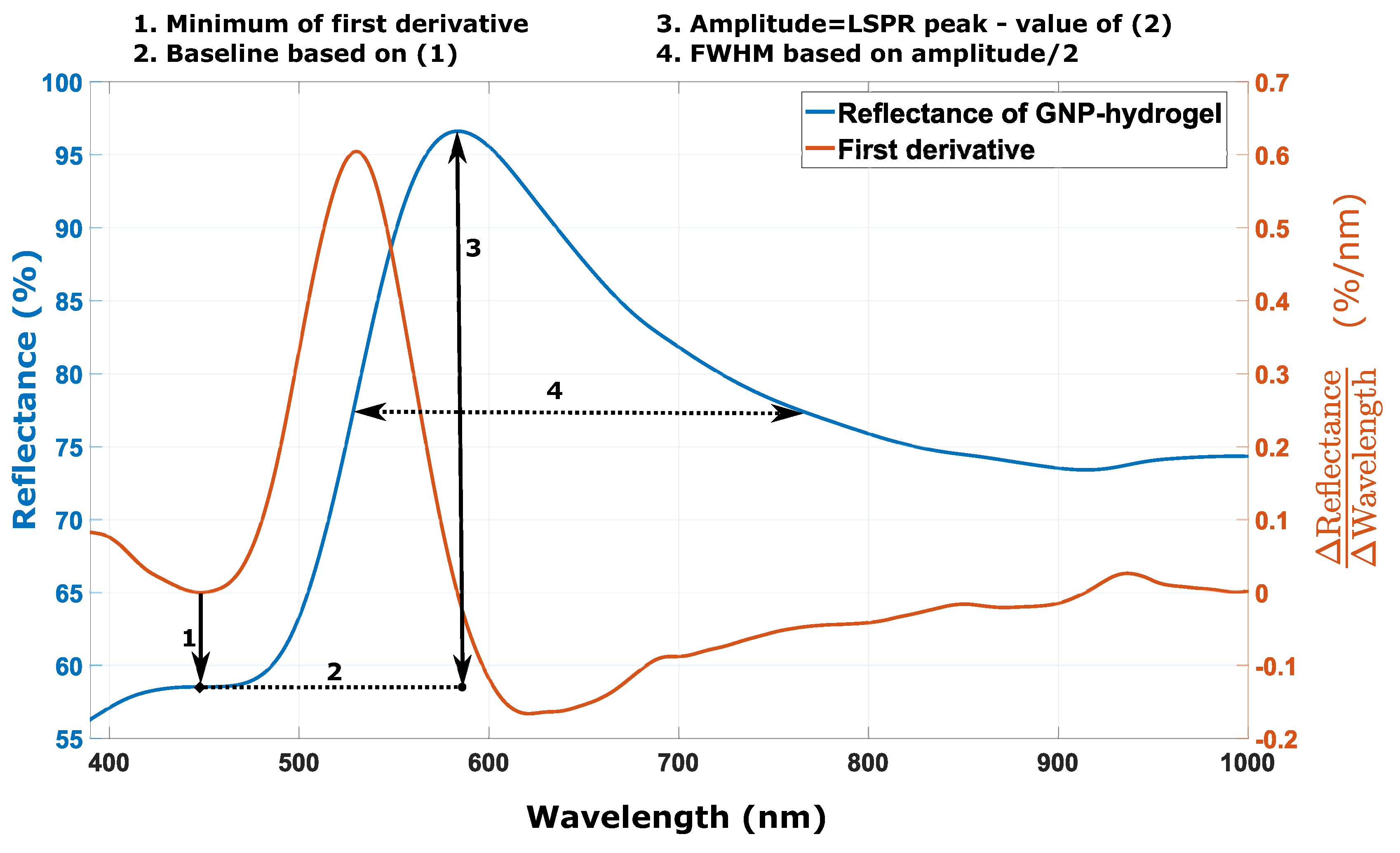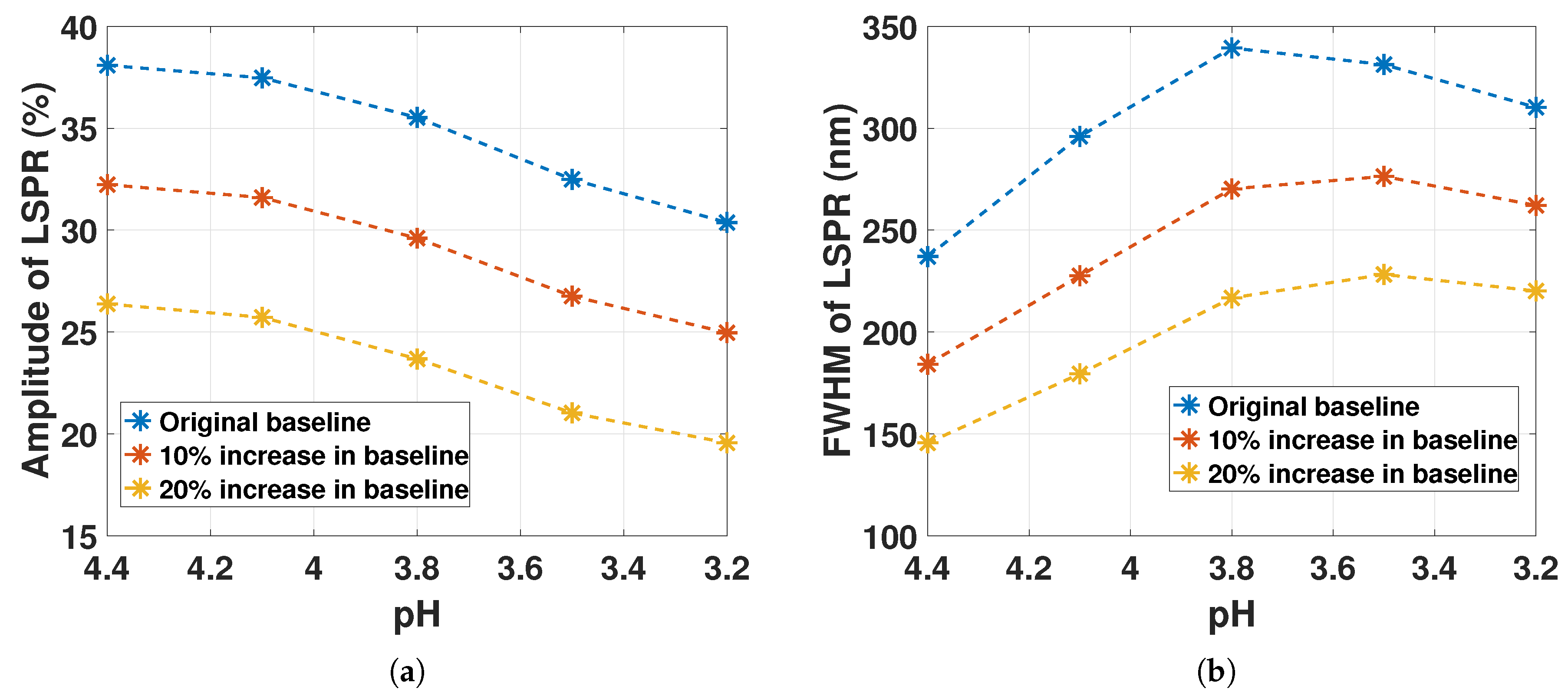First, the NNDF was estimated for increasing GNP densities in hydrogel to assess the distribution of interparticle distances for the hydrogel swelling degree. The RI as a function of hydrogel deswelling was estimated based on the estimation of the mole fraction of polymer and water. Second, the sources of reflections in the hydrogel were investigated with respect to the LSPR reflectance spectrum to determine possible errors included in the value of the LSPR peak with corresponding wavelength. Third, the LSPR response was demonstrated by measuring its peak positions as a function of GNP-hydrogel contraction controlled with pH solutions and as a function of increasing . Last, the linewidth and the amplitude of the LSPR signal were characterized for hydrogel deswelling stimulated with pH solutions to compare the LSPR reflectance spectrum with the estimated NNDF of GNPs in hydrogel.
4.1. Nearest-Neighbor Distribution Function for Increasing GNP Density in the Hydrogel
Figure 5 shows the measured volume of pregel to the volume of hydrogel (
) ratio based on the observations obtained from optical microscope imaging.
Three different pregels with different GNP densities at , and particles/mL were used to manufacture the OF sensors. The ratio was estimated for hydrogel contraction controlled with pH solutions from 5 to 3. as a function of decreasing pH follows the same trend for the OF sensors fabricated from different densities of GNP in pregel. The NDs of GNPs found for the deswelling hydrogels are further used to compute the NNDF.
In
Figure 6a, the NNDFs (Equation (
11)) are computed for pH 5 and 3 (from the NDs in
Figure 5) of the OF sensors manufactured from different GNP-pregel densities. The probability at the mean interparticle distance
is increasing for increasing ND and hydrogel contraction. The smallest
for the largest ND and lowest pH is greater than
, i.e., greater than the range where the interaction between dipoles of GNPs occurs.
The probability (Equation (
12)) of finding particles with interparticle distance between
(computed from NDs in
Figure 5) is represented in
Figure 6b. The probability is increasing from
to
for increasing ND and hydrogel contraction. The low probability for
shows that there is only a small fraction of GNPs with interparticle distances inducing dipole-dipole interactions. Hence, for a truly random distribution of GNPs in hydrogel at pH 5 and 3, it is the increasing density of the polymer network and not the dipole-dipole interactions that should be the dominating factor for the change in the LSPR peak position. If the change in LSPR peak position is independent of ND in our experiments, the assumption of having particles randomly distributed in the hydrogel would be reasonable. On the contrary, if the LSPR peak position is dependent on the ND, the GNPs may be inhomogeneously distributed in the hydrogel with a large fraction of particles with
.
4.2. Refractive Index as a Function of Hydrogel Swelling Degree
The RI of the hydrogel can be assessed from Equation (
13) by computing the mole fraction of the polymer in Equation (
17). The RI of the polymer can be assumed to be dominated by the mole and mass fraction of AAM-AAC. For our experiments, the mass fraction of AAM-AAC is
. With
and
[
19,
20],
from Equation (
13) and (
17) can be computed as a function of
(from
Figure 5) for pH 5 to 3 as presented in
Figure 7a.
Deswelling of the hydrogel for pH 5 to 3 increases
from ∼1.333 to ∼1.346. Inserting
at 1.333 and 1.346 into Equation (
1) with
, the scattering of GNP can be computed as shown in
Figure 7b.
The scattering of GNPs redshifts by 2 to 3 nm with hydrogel contraction stimulated with pH from 5 to 3. Its important to note that the LSPR is dependent on the mole fraction of polymer chains that are in close proximity to the plasmonic wave of the GNPs. Due to the localized sensing of the RI changes on the surface of the GNPs,
in Equation (
1) and
in Equation (
13) would rather represent the local RI and the bulk RI of the hydrogel, respectively. Hence, the LSPR response of GNPs could be different for bulk and local RI changes.
4.3. The Reflectance for Different GNP Densities
Figure 8a–c shows reflectance spectra for
particles/mL (pH 5),
particles/mL (pH 5) and for
particles/mL (pH 4.4), respectively (NDs found from
Figure 5). The reflectance measurements of hydrogel without GNPs are shown in
Figure 8d for pH 5 to 3.
The LSPR peaks are at 561 nm, 575 nm and 583 nm for
particles/mL,
particles/mL and
particles/mL, respectively. The increasing ND of GNPs is redshifting the LSPR signal, while its linewidth is broadening. That the LSPR peak position is dependent on the ND indicates an electrostatic interaction between the dipoles. This contrasts with the computed NNDF in
Section 4.1, where only a minor fraction of GNPs was estimated to have interparticle distances less than
. The particles in the hydrogel may not exhibit a random distribution, but could rather exhibit an inhomogeneous distribution with a large fraction of GNPs with interparticle distances between
.
The spectra in
Figure 8a–c may contain reflections other than scattering from GNP that could result in errors in the LSPR peak position value. Not only light scattering, but also light extinction of GNP occurs due to the reflection at the hydrogel-solution interface. The extinction of GNPs will add a spectrum of opposite sign to the LSPR signal relative to the scattered spectrum of GNP. The sources of scattering and extinction of GNP and hydrogel can be listed as illustrated in
Figure 9.
The reflection at a normal incidence (2) can be assumed to be roughly 0.002 at the fiber-gel interface. The reflection (8, 6) at the hydrogel-solution interface has in previous work been determined based on visibility measurements [
21]. With reflection at 0.002 for the fiber-gel interface and with visibility at 0.2, the reflection (8, 6) at the hydrogel-solution interface can be estimated to be 0.0002. Multiple reflections between the hydrogel-solution and fiber-gel interface can then be safely neglected. Hence, at the LSPR wavelength, the scattering combined with extinction of GNP (7) is dominated by the scattering from (4) as its intensity is much higher than the reflection from (6).
The reflectance measurements of hydrogel without GNP in
Figure 8d have a decreasing slope and an increasing reflectance from pH 5 to 3. The change in the slope from the reflectance of the hydrogel will also change the observed LSPR peak position from the reflectance of the GNPs. The reflectance of GNP-hydrogel can be modeled with two functions, the reflectance of the hydrogel without GNPs and the LSPR signal from the GNPs, here modeled as a Gaussian function
. Thus, we can write,
where
represents the reflection of both GNP and hydrogel with
as a scaling factor for the reflection from the hydrogel without GNPs,
.
Assuming that
, the LSPR peak position as a function of
can be described by setting
,
where
.
and
are the peak position and amplitude, respectively, of the LSPR signal represented as
. The derivative of
with respect to
determines the shift of
with changing slope
,
For the reflectance of hydrogel without GNPs in
Figure 8d,
can be estimated to be
with
for the change in pH from 5 to 3.8. The factor
from the LSPR signal will also determine the shift
. For the GNP-hydrogel with low ND in
Figure 8a,b,
will be large. Thus, an increase in the slope will lead to a redshift of the LSPR signal, whereas a decrease in slope will lead to a blueshift. For the GNP-hydrogel with high ND in
Figure 8c,
will be small. The increase or decrease in slope will in this case lead to negligible red or blueshifts of the LSPR signal.
4.4. LSPR Peak Position as a Function of Hydrogel Swelling Degree
The reflectance spectra of GNP-hydrogel with
at
particles/mL fitted with a smoothing spline function are shown in
Figure 10a for pH solutions from 5 to 3.4. The resulting LSPR peak positions as a function of hydrogel contraction stimulated with pH solutions are presented in
Figure 10b.
The reflectance peak is increasing for decreasing pH. As discussed in
Section 4.3 for the OF sensor with
, the reflectance spectrum will be a sum of the scattering from GNPs with an added slope from the light extinction of the hydrogel. The increase in reflectance peak in
Figure 10a may be due to the increase in the reflectance of the hydrogel contraction as observed from
Figure 8d. The LSPR peak positions in
Figure 10b are changing from 562 nm to 557 nm as a function of hydrogel deswelling. For decreasing pH, the slope from the reflectance of the hydrogel is declining as discussed in
Section 4.3. From pH 5 to 3.8, the linear function
in
Figure 10a has a change in slope of
between 450 nm and 750 nm that is comparable to
for the reflectance of hydrogel without GNPs in
Figure 8d.
from Equation (
21) can be estimated to be ∼2.25 nm based on the reflectance of GNP-hydrogel in
Figure 10a (setting
, FWHM = 61 nm,
and
). As discussed in
Section 4.2, an increasing mole fraction of polymer in close proximity to the plasmonic wave of the GNPs could also redshift the LSPR signal by 2 to 3 nm. Hence, the blueshift of the LSPR peak in
Figure 10b is due to the reduced slope from the reflectance of hydrogel for pH 5 to 3.4, as well as a result of the local variations of the RI in the hydrogel for the increasing mole fraction of polymer. With
at
particles/mL, there is then little contribution from the dipole-dipole interactions on the LSPR signal.
Figure 11 represents the reflectance spectra of GNP-hydrogel with increased ND to
at
particles/mL fitted with a smoothing spline function for hydrogel deswelling and the corresponding LSPR peak positions.
The reflectance peak is increasing for pH 5 to 3.8. The increase may be a result of the increase in reflectance of the hydrogel for declining pH as discussed in
Section 4.3. For pH 3.8 to 3.4, the ND of GNPs in the hydrogel increases from
particles/mL to
particles/mL (estimated from data in
Figure 5), whereas the amplitude is declining and the linewidth is broadening (linewidth and amplitude estimated in
Section 4.5). The decline in the reflectance peak from pH 3.8 to 3.4 is due to the decrease in the amplitude of the LSPR signal that is smaller than the increase in the reflectance of the hydrogel observed in
Figure 8d. A decreasing amplitude for higher ND suggests also the hypothesis that there is a larger dispersion in particle scattering, which may be caused by the increased fraction of particles interacting, as well as the increased variation in local RI. The linewidth broadening is likely due to the increasing RI and the decrease in
inducing dipole-dipole interactions.
The LSPR peak positions in
Figure 11a as a function of hydrogel contraction controlled with pH solutions are presented in
Figure 11b. The LSPR peak position is redshifting from 578 nm to 610 nm from pH 5 to 3.4. The change in the LSPR peak position in
Figure 11b for decreasing pH is now due to three factors: (1) the RI change as a function of hydrogel contraction presented in
Section 4.2 results in a redshift of 2 to 3 nm; (2) the change in the slope of
from pH 5 to 3.8 in
Figure 11a that results in a blueshift of 2 to 2.5 nm (see discussion from
Figure 10); (3) the decrease in
inducing electrostatic interactions between of the GNPs results in redshift of the LSPR signal. The change in LSPR peaks in
Figure 10 and
Figure 11 shows a different response to the hydrogel deswelling due to the different amounts of GNPs immobilized in the hydrogel. By changing the density of GNPs in pregel from
to
, the LSPR response for hydrogel contraction becomes dependent on the decreasing
as a result of the increasing fraction of GNPs with
. Whereas the results in
Figure 10 show a small blueshift of the LSPR due to the change in the slope
with little influence from the dipole-dipole interactions, the results in
Figure 11 show a large redshifting of the LSPR due to the large influence of dipole-dipole interactions and with little influence from the slope
.
Finally, the LSPR peak position was measured as a function of hydrogel deswelling stimulated with decreasing pH with even higher
at
particles/mL in
Figure 12.
The reflectance spectra of GNP-hydrogel for pH 4.4 to 3.2 fitted with a smoothing spline function are shown in
Figure 12a, while the LSPR peak positions as a function of decreasing pH are presented in
Figure 12b. The reflectance peak is decreasing, while the linewidth of the reflectance is broadening for hydrogel contraction. From pH 4.4 to 3.2, the ND increases from
particles/mL to
particles/mL (estimated from
Figure 5). It is evident that the change in the amplitude of the LSPR signal from scattering of GNPs in
Figure 12a dominates over the change in reflectance of the hydrogel observed in
Figure 8d for the decrease in pH (linewidth and amplitude estimated in
Section 4.5).
The decrease in amplitude of the LSPR signal from pH 4.4 to 3.2 may be a result of the increasing ND of GNPs from
particles/mL to
particles/mL (from data in
Figure 5) that increases the dispersion in particle scattering caused by the increased fraction of particle interaction and the increased change in the variations of the local RI. The linewidth broadening is likely due to the increase in RI and the decrease in
inducing dipole-dipole interactions.
In
Figure 12a, the LSPR peak position is redshifting from 584 nm to 648 nm for hydrogel deswelling. The change of the shift is 64 nm, which is much larger than the shift of 2 to 3 nm from the change in RI for hydrogel contraction discussed in
Section 4.2.
from Equation (
21) can be estimated to be ∼2.65 nm (with
, with
and FWHM = 237 nm). With
nm and minor RI changes for hydrogel contraction, the redshift of LSPR peak position observed in
Figure 12b is most likely dominated by the reduced
inducing dipole-dipole interactions between the GNPs.
4.5. Amplitude and Linewidth of the LSPR Signal as a Function of Hydrogel Swelling Degree
The amplitude and the linewidth of the LSPR signal from the reflectance spectra of GNP-hydrogel with
at
particles/mL for decreasing pH were determined based on the procedure illustrated in
Figure 13.
The first inflection point of the LSPR signal is used as the baseline for determining the amplitude and the linewidth of the reflectance of GNP-hydrogel. The LSPR reflectance peak subtracted from the baseline represents the amplitude. The linewidth of the LSPR signal is defined as the FWHM from the half maximum value. Due to the asymmetry of the signal, the procedure will tend to overestimate the linewidth. To account for this, the FWHM was further characterized by varying the baseline with respect to the inflection point. The baseline increasing by 10% and 20% proportionally to the inflection point from
Figure 13 reduces both the FWHM and the amplitude, but will represent a value less dependent on the change in the asymmetry of the LSPR signal.
Figure 14 shows the resulting amplitude and FWHM from the reflectance spectra of GNP-hydrogel from
Figure 12 as a function hydrogel contraction. In
Figure 14a, the amplitude of the LSPR signal is decreasing monotonically for pH 4.4 to 3.2, independent of the baseline. The LSPR peak position response in
Figure 12 was concluded to be dominated by the reduced
, inducing dipole-dipole interactions between the GNPs with minor influence from the local variations of the RI change in the hydrogel and the change in the slope
from the light extinction of hydrogel for decreasing pH. The declining amplitude in
Figure 14a would imply as discussed in
Section 4.4 a larger dispersion in particle scattering for higher ND. A larger dispersion in particle scattering may be caused by the increased fraction of interacting particles and the variations in the local RI.
The FWHM in
Figure 14b is increasing from pH 4.4 to 3.5. From pH 3.5 to 3.2, the FWHM decreases for the 10% and the 20% increase in the baseline, while for the original baseline, it decreases from pH 3.8 to 3.2. The increase in FWHM is likely a result of the increasing RI and the dipole-dipole interaction between the GNPs. The decrease in FWHM from pH 3.8 to 3.2 might be due to the change in the reflection of the fiber-gel interface observed in
Figure 8d, which changes the signature of the LSPR signal.
